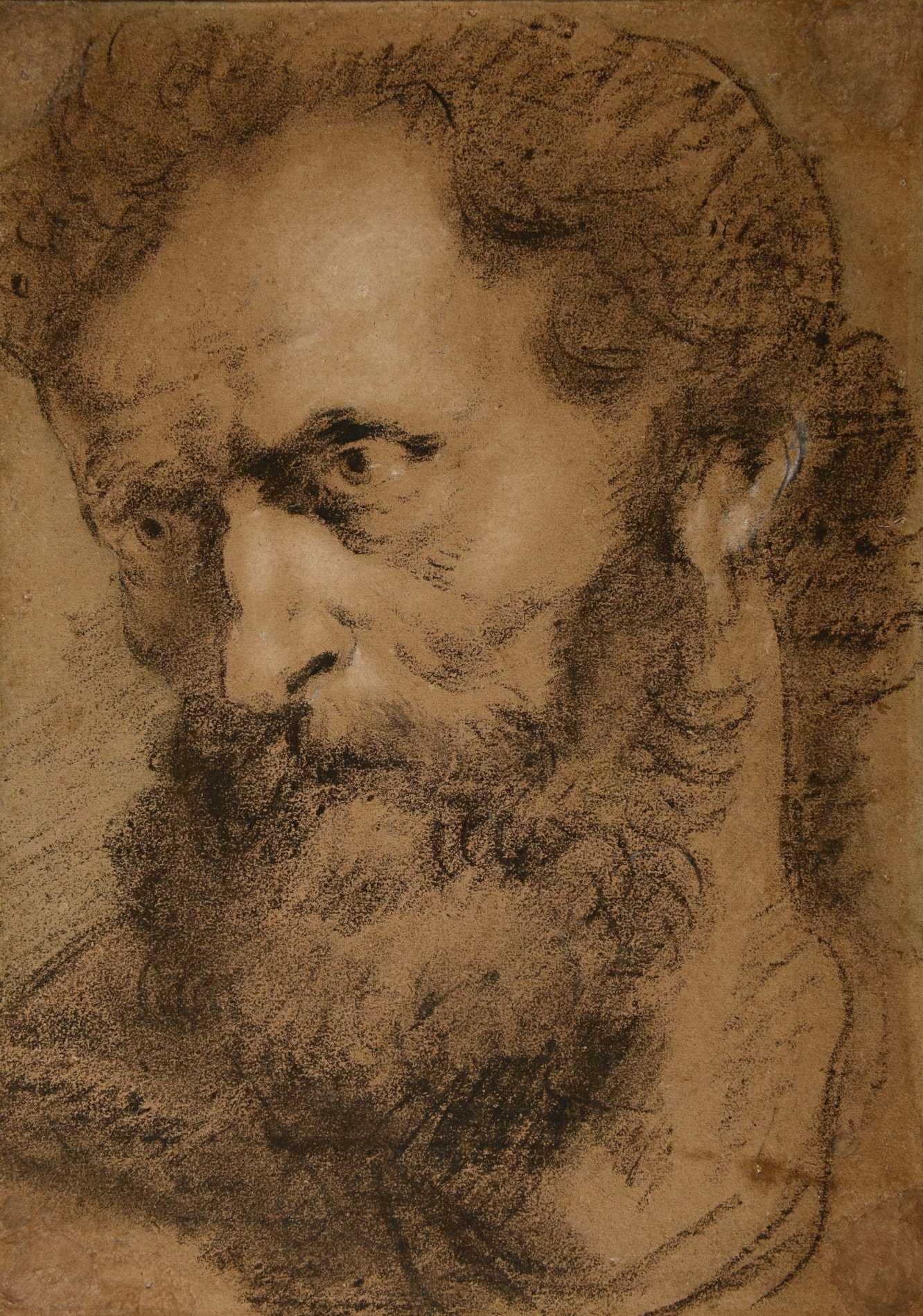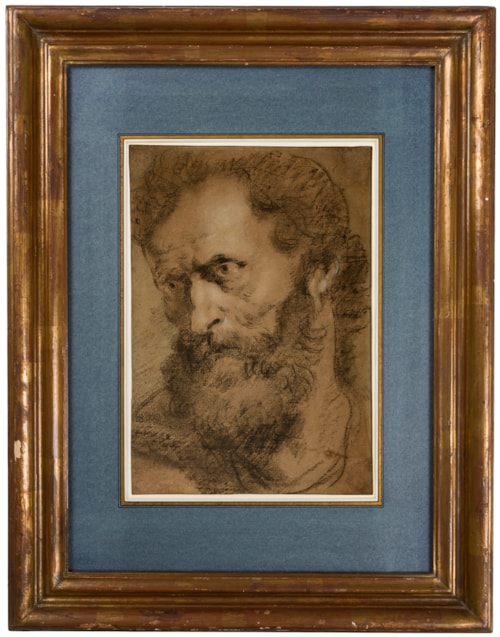Circle of Anthony VAN DYCK
(Antwerp 1599 - London 1641)
The Head of an Apostle
Sold
Black chalk, heightened with touches of white chalk, with framing lines in brown ink, on brown paper.
Laid down.
Numbered 2882 in red ink on the on the backing sheet.
Extensively inscribed (by van der Marck) pastel [?] / en B [?] / Paulus Rubens / Gabriel Huquiers vente / te [?] Sept. 1761 [?]on the backing sheet.
372 x 260 mm. (14 5/8 x 10 1/4 in.)
Laid down.
Numbered 2882 in red ink on the on the backing sheet.
Extensively inscribed (by van der Marck) pastel [?] / en B [?] / Paulus Rubens / Gabriel Huquiers vente / te [?] Sept. 1761 [?]on the backing sheet.
372 x 260 mm. (14 5/8 x 10 1/4 in.)
Long thought to be by Peter Paul Rubens, the present sheet may be related to Anthony Van Dyck’s small panel painting of the apostle Saint Jude (Judas Thaddeus) in the Kunsthistorisches Museum in Vienna, of which a later autograph version is in the Museum Boijmans-van Beuningen in Rotterdam. Both early works are part of two different series of paintings of Christ and the Twelve Apostles, datable to Van Dyck’s first Antwerp period, between c.1618 and 1620. Although this drawing was included in the 1976-1977 exhibition of the Van Regteren Altena collection as a preparatory study by Van Dyck for the painting in Vienna, the attribution to the master was rejected in the 2004 catalogue raisonné of Van Dyck’s paintings.
A plausible attribution to the Flemish artist Lucas Franchoys the Younger (1616-1681) has been suggested by several scholars. Born into a family of artists in Mechelen (or Malines), Franchoys received his initial artistic training from his father, Lucas Franchoys the Elder, before entering the Antwerp studio of Rubens in the late 1630s. He became one of the most talented of Rubens’s followers, although his work also shows the distinct influence of Van Dyck. Franchoys’s first recorded commissions are dated to the end of the 1640s, for various churches and monasteries in Tournai, including an Annunciation in the cathedral, dated 1649, and a Beheading of Saint John the Baptist, painted in 1650 for the church of Saint-Quentin. Franchoys was back in Mechelen by 1654, and worked there until his death. He enjoyed a successful career, and among his most significant commissions was a triptych of scenes from the life of Saint Roch, painted between 1669 and 1672 for the church of Saint-Jean-l’Evangeliste et Saint-Jean-Baptiste in Mechelen, as well as two canvases of The Preaching of Saint Peter and The Preaching of Saint Paul for the same church, completed in 1673. His most important patron was Alphonse de Bergues, the future archbishop of Mechelen, who commissioned several works for local churches and monasteries. Best known as a portrait and history painter, Franchoys was registered in the artist’s guild in Mechelen in 1655, and served as dean of the guild in 1663.
Only a handful of drawings by Lucas Franchoys are known, some of which are drawn in black and white chalk on blue paper. The influence of both Rubens and Van Dyck is evident in the few drawings and oil sketches by Franchoys that survive.
The first recorded owner of this drawing was the French engraver, print publisher and collector Gabriel Huquier (1695-1772), who attributed the drawing to Rubens. Huquier owned some forty drawings by or attributed to Rubens. Along with some 4,500 drawings from Huquier’s collection, the present sheet was sold at auction in Amsterdam in 1761, when it was purchased by Johan van der Marck (1707-1772), burgomaster of Leiden, who noted the acquisition in an inscription on the backing sheet. Van der Marck’s collection of some 2,300 drawings was dispersed at auction in Amsterdam in 1773.
A plausible attribution to the Flemish artist Lucas Franchoys the Younger (1616-1681) has been suggested by several scholars. Born into a family of artists in Mechelen (or Malines), Franchoys received his initial artistic training from his father, Lucas Franchoys the Elder, before entering the Antwerp studio of Rubens in the late 1630s. He became one of the most talented of Rubens’s followers, although his work also shows the distinct influence of Van Dyck. Franchoys’s first recorded commissions are dated to the end of the 1640s, for various churches and monasteries in Tournai, including an Annunciation in the cathedral, dated 1649, and a Beheading of Saint John the Baptist, painted in 1650 for the church of Saint-Quentin. Franchoys was back in Mechelen by 1654, and worked there until his death. He enjoyed a successful career, and among his most significant commissions was a triptych of scenes from the life of Saint Roch, painted between 1669 and 1672 for the church of Saint-Jean-l’Evangeliste et Saint-Jean-Baptiste in Mechelen, as well as two canvases of The Preaching of Saint Peter and The Preaching of Saint Paul for the same church, completed in 1673. His most important patron was Alphonse de Bergues, the future archbishop of Mechelen, who commissioned several works for local churches and monasteries. Best known as a portrait and history painter, Franchoys was registered in the artist’s guild in Mechelen in 1655, and served as dean of the guild in 1663.
Only a handful of drawings by Lucas Franchoys are known, some of which are drawn in black and white chalk on blue paper. The influence of both Rubens and Van Dyck is evident in the few drawings and oil sketches by Franchoys that survive.
The first recorded owner of this drawing was the French engraver, print publisher and collector Gabriel Huquier (1695-1772), who attributed the drawing to Rubens. Huquier owned some forty drawings by or attributed to Rubens. Along with some 4,500 drawings from Huquier’s collection, the present sheet was sold at auction in Amsterdam in 1761, when it was purchased by Johan van der Marck (1707-1772), burgomaster of Leiden, who noted the acquisition in an inscription on the backing sheet. Van der Marck’s collection of some 2,300 drawings was dispersed at auction in Amsterdam in 1773.
Provenance
Gabriel Huquier, Paris
His sale, Amsterdam, Pierre Yver, 14-26 September 1761, lot 760 (as Rubens, Une Tête d’Homme pensif, dessinée au crayon noir & blanc, par le même [P. P. Rubens]., bt. Fouquer [for van der Marck?] for 1 fl., 5 s.)
Johan van der Marck Aegidiusz., Leiden (Lugt 3001) with his inscription on the backing sheet
His posthumous sale, Amsterdam, de Winter & Yver, 29 November 1773 onwards, Konstboek P, lot 1430 (as Rubens: Een Man Hoofd met een Baard, met zwart en wit Kryt op graauw Papier getekend, h.14 b 10 1/4 duim., bt. Vollenhoven for 1 guilder)
J(acobus?) Vollenhoven
Private collection, Sierre, Switzerland
Iohan Quirijn van Regteren Altena, Amsterdam (with his posthumous sale stamp [Lugt 4617] stamped on the backing sheet)
Thence by descent.
His sale, Amsterdam, Pierre Yver, 14-26 September 1761, lot 760 (as Rubens, Une Tête d’Homme pensif, dessinée au crayon noir & blanc, par le même [P. P. Rubens]., bt. Fouquer [for van der Marck?] for 1 fl., 5 s.)
Johan van der Marck Aegidiusz., Leiden (Lugt 3001) with his inscription on the backing sheet
His posthumous sale, Amsterdam, de Winter & Yver, 29 November 1773 onwards, Konstboek P, lot 1430 (as Rubens: Een Man Hoofd met een Baard, met zwart en wit Kryt op graauw Papier getekend, h.14 b 10 1/4 duim., bt. Vollenhoven for 1 guilder)
J(acobus?) Vollenhoven
Private collection, Sierre, Switzerland
Iohan Quirijn van Regteren Altena, Amsterdam (with his posthumous sale stamp [Lugt 4617] stamped on the backing sheet)
Thence by descent.
Literature
Jeroen Giltaij, Le cabinet d’un amateur: Dessins flamands et hollandaises des XVIe et XVIIe siècles d’une collection privée d’Amsterdam, exhibition catalogue, Rotterdam and elsewhere, 1976-1977, pp.28-29, no.48, illustrated pl.107 (as Van Dyck); Susan J. Barnes, Nora de Poorter, Oliver Millar and Horst Vey, Van Dyck: A Complete Catalogue of the Paintings, New Haven and London, 2004, p.72, under no.I.56 (as not by Van Dyck).
Exhibition
Rotterdam, Museum Boymans-van Beuningen, Paris, Institut Néerlandais and Brussels, Bibliotheque Albert Ier, Le cabinet d’un amateur: Dessins flamands et hollandaises des XVIe et XVIIe siècles d’une collection privée d’Amsterdam, 1976-1977, no.48 (as Van Dyck).





